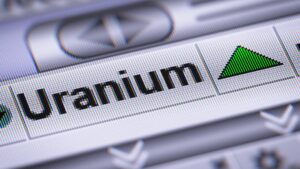Why Tribeca’s Guy Keller plans to lead, not follow, on the next uranium move

Uranium bulls tend to be fast out of the gates. Pic: Getty Images
- Tribeca’s Guy Keller says weak uranium equity sentiment in 2024 disguises strong fundamentals for the nuclear fuel
- Forecast Kazakh production cuts will put further pressure on an already strained global uranium supply pipeline
- Prices need to rise beyond strong recent levels of ~US$80/lb to incentivise new mines
One of Australia’s leading fund managers focused on the nuclear sector has warned the West has become complacent about uranium mine supply, setting the scene for another breakout.
Guy Keller’s conviction on the uranium bull thesis has paid off thus far, with the Tribeca Nuclear Energy Opportunities Strategy fund he manages rising 39.15% per annum since inception.
That tracked a period from 2018 to 2024 when prices of uranium oxide, the building blocks of nuclear fuel, rose from virtually uneconomic levels of US$18/lb to US$107/lb earlier this year.
Macroeconomic bearishness and moderating uranium prices, which have trended downwards since January to US$79.50/lb, have sent equities lower.
The Global X Uranium ETF, which tracks the major uranium producers and developers across multiple stock markets, was down 6.81% YTD on Tuesday.
But Keller views many Aussie uranium stocks as ‘half price’, saying the fundamental mismatch between supply and demand for a growing nuclear energy market has no solution on the horizon.
“Considering all of the macro uncertainty we’ve had through July, August and beginning of September, the spot price has actually held extraordinarily well,” Keller told Stockhead.
“What you’re going to find is just because it doesn’t move doesn’t mean there’s not things happening. 98% of the actual physical activity happens on a long term contract price, not the spot price.
“As we’ve seen in the past, when this sector releases, it moves really, really quickly. It almost goes vertical over a very short period of time.
“If investors believe the thematic and they’re happy to accept they’re going to get a boost from some seasonality, then waiting for the spot to move is probably going to mean that you’re chasing your tail.
“I’ve been in this sector for almost eight years, and I can tell you every time you try to chase it, it’s extraordinarily difficult.”
What the market is missing
While his suggestions earlier this year that uranium could go as high as US$175/lb (which would be a record) are a long way from coming to life, Keller says the mild sentiment towards uranium stocks through the middle of the year shows the market is missing some important facts on fundamentals.
In recent months, the downstream end of the uranium sector has been the focus of funding and policy calls from the US Government, which is seeking to a bypass Russia’s dominance in the supply of enriched uranium.
But if anywhere really needs the investment, it’s the upstream end, the mines that supply the raw material for nuclear fuel to supply an industry COP28 delegate want to grow three times over by 2050 to address climate change.
That is especially stark now that Kazakhstan’s Kazatomprom, the world’s biggest producer of yellowcake, has dramatically reduced production guidance for 2025.
“It’s sending the message that even well established companies that know what they’re doing are having difficulty in flexing new supply. I actually don’t think they’re going to grow supply next year at all,” Keller said.
“I think they’re going to be flat year on year. And the 25,500t of uranium that they’re guiding to, they have to put that number, because that’s the bottom end of their subsoil use agreement.
“If they were guiding any lower than that, then they have to go back to the government and renegotiate everything, which is obviously a little bit of a loss of face.”
Keller said Kazatomprom has regularly overpromised and underdelivered since 2017.
“I think that’s extraordinarily relevant, because we’re now going to have to look elsewhere for new sources of supply just to almost stay break even,” he said.
“All the new sources of supply coming on aren’t really adding much, because we’re losing it from the Kazakhs.”
Kazakh supply largely goes not to the West, but to Russia and China, Keller adds. While the US Government is putting taxpayer dollars into building enrichment capabilities onshore, it remains complacent about mine supply.
“Anything downstream from from mine gate is attracting attention, and probably so it should, because there’s not many private companies doing conversion enrichment or fuel fabrication,” Keller said.
“Yet the government seems to think that the market will solve the uranium supply equation, and that takes time.
“As we know, it takes a long time to bring any mining project to market. When it’s uranium as the commodity it takes even longer, because there’s just that much more that needs to be done, and there’s that much more community passion and First Nation opinions because it’s uranium.”
Spot market whittling down
While gas prices were kept in check a decade ago after the discovery of the Permian Basin in Texas, Keller says there’s no analogue in uranium that could ameliorate the shortage of new supply from 15 years of underinvestment.
That suggests prices will need to go even higher to incentivise well-known development-ready assets to commit to new builds.
“I think the really interesting thing for the next five years is there’s no magic solve. There’s no Permian Basin of uranium that’s going to come to the come to the rescue,” Keller said.
“The big uranium jurisdictions being Kazakhstan and the Athabasca basin in Canada, we largely know about them already.
“We’re struggling at the moment, even at US$80, to encourage and incentivise enough supply to make up today’s mine supply deficit. And we’ve been running primary mine supply deficits for a decade, so inventory has been whittled down over that period.”
This puts uranium, in Kellers’ view, in stark contrast to battery metals like lithium which quickly flipped from under to oversupply, strangling prices.
“I just don’t think we’ll see that in uranium, because it’s just not physically possible for the amount of supply that we’re going to require even by 2030” he said.
“There’s decisions that needed to be made last year or today, at the latest, to be able to guarantee that we’re going to be getting that by the latter part of this decade.”
Opportunity knocks
Keller said the producers like Boss and Paladin would be the first to benefit when sentiment turns.
There were already hints of that earlier this week as Boss, Paladin and developers like Deep Yellow (ASX:DYL) and Lotus Resources (ASX:LOT) surged off the back of two items of news.
First was Microsoft’s backing of a restart at the Three Mile Island plant in Pennsylvania to power its data centres, with the second a commitment from 14 major banks to support a tripling of nuclear power capacity by 2050.
Once the capital moves down the pecking order, the key will be exploration success, Keller believes.
“I think the market will allocate there first but it generally doesn’t take long for it to move down the stack and there’s a few development plays on the ASX, but there’s also a number of smaller explorers that are going to be doing some interesting things,” he said.
“Australian investors love good exploration plays, because they like the possibility of what it can do when that explorer finds uranium.
“I think it probably looks pretty good into the end of this year.”
Seasonality is also a big factor in uranium demand, with contracting typically accelerating in the latter months of the year after the World Nuclear Association symposium in September.
In that vein a number of explorers have drilling results on the way, looking to progress their developments in the final stretch of 2024.
GTI Energy (ASX:GTR) is one explorer with newsflow on the horizon, with 73 drill holes completed this year to expand the resource at its Lo Herma ISR project in Wyoming, USA.
Drilling from the 16,205m program recently returned deeper mineralisation at elevated grades include a 1m intersection at 0.185% U3O8. An updated mineral resource estimate and exploration target is due by the year’s end.
Koba Resources (ASX:KOB) was up 20% yesterday as drilling progressed at its Yarramba uranium project in South Australia, where 70 holes for 7500m will be drilled into the Oban deposit, which previous returned hits like 7.5m at 831ppm U3O8 and 2.1m at 2236ppm U3O8.
3000m will be sunk into 30 holes at the nearby Mt John, which is located just 4km from Boss’ 10.7Mlb Jasons deposit, a potential satellite of the Honeymoon uranium mine.
Meanwhile in WA, where a string of explorers are hoping to overturn a virtual mining ban put in place by the Labor State Government, Cauldron Energy (ASX:CXU) is raising cash to chase additional targets having previously declared a significant discovery at the Manyingee South project near Paladin’s Manyingee in the Pilbara.
Toro Energy (ASX:TOE) also announced a 17% lift in uranium resources to 73.6Mlb at the Wiluna project after recutting its resource at a lower cutoff to account for the lift in uranium prices.
At Stockhead, we tell it like it is. While GTI Energy and Koba Resources were Stockhead advertisers at the time of writing, they did not sponsor this article.
The views, information, or opinions expressed in the interviews in this article are solely those of the interviewee and do not represent the views of Stockhead.
Stockhead does not provide, endorse or otherwise assume responsibility for any financial product advice contained in this article.

UNLOCK INSIGHTS
Discover the untold stories of emerging ASX stocks.
Daily news and expert analysis, it's free to subscribe.
By proceeding, you confirm you understand that we handle personal information in accordance with our Privacy Policy.








